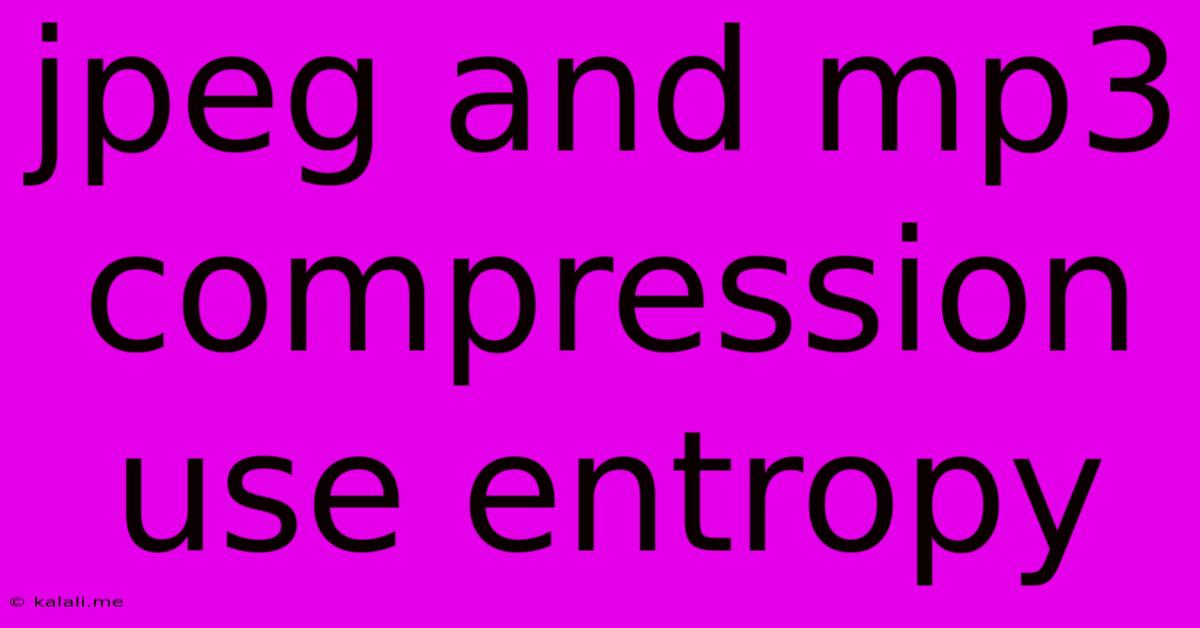Jpeg And Mp3 Compression Use Entropy
Kalali
Jun 05, 2025 · 3 min read

Table of Contents
JPEG and MP3 Compression: Harnessing the Power of Entropy
Meta Description: JPEG and MP3 files leverage entropy encoding to achieve impressive compression ratios. This article delves into how these popular formats utilize this concept to reduce file sizes without significant loss of perceived quality. Learn about the role of entropy in data compression and the specific techniques employed by JPEG and MP3.
Digital images and music files often occupy significant storage space. To address this, compression techniques are crucial. JPEG (for images) and MP3 (for audio) are prime examples of lossy compression algorithms that achieve remarkable size reductions without causing overly noticeable quality degradation. A key element underpinning their success is the principle of entropy encoding. This article explores how entropy, a measure of disorder or randomness in data, plays a vital role in the compression mechanisms of JPEG and MP3.
Understanding Entropy in Data Compression
Entropy, in the context of information theory, quantifies the uncertainty or randomness inherent in data. Data with high entropy has many equally likely possibilities, making it difficult to predict. Conversely, data with low entropy is more predictable and contains repetitive patterns. Compression algorithms exploit this difference: they represent highly probable data elements using fewer bits than less probable ones. This efficient representation leads to smaller file sizes.
JPEG Compression and Entropy: A Closer Look
JPEG, the ubiquitous image format, employs a sophisticated compression scheme involving several steps. One crucial step is Discrete Cosine Transform (DCT). The DCT converts spatial image data into frequency components. High-frequency components represent fine details, while low-frequency components represent overall brightness and large-scale features. Many images contain more low-frequency information than high-frequency details.
After the DCT, quantization discards less significant high-frequency coefficients. This is where lossy compression occurs; however, the discarded information is often imperceptible to the human eye. Finally, entropy encoding (usually Huffman coding or arithmetic coding) assigns shorter codes to more frequent coefficients (low-frequency components), resulting in further size reduction. The more predictable the data (after quantization), the more effective the entropy encoding becomes. This is why JPEG achieves higher compression ratios for images with smooth gradients and fewer sharp details.
MP3 Compression and Entropy: The Magic of Psychoacoustics
MP3, a dominant audio format, leverages a different approach to compression, heavily relying on the principles of psychoacoustics. Psychoacoustics studies how humans perceive sound. MP3 exploits the fact that certain audio frequencies are masked by others, making them inaudible under specific conditions.
MP3's compression begins with a modified discrete cosine transform (MDCT) that transforms the audio signal into frequency components. Then, a process called psychoacoustic modeling analyzes these components to identify frequencies that are likely to be masked and can be discarded or represented with fewer bits without impacting the perceived sound quality. Finally, like JPEG, entropy coding is used to efficiently represent the remaining frequency data. Frequencies deemed less important based on psychoacoustic modeling are assigned longer codes, resulting in better compression, while salient features are given priority and efficient encoding.
Conclusion: Entropy's Crucial Role
Both JPEG and MP3 compression algorithms effectively leverage entropy encoding to significantly reduce file sizes while preserving acceptable perceptual quality. By exploiting the statistical properties of image and audio data, these algorithms efficiently represent more probable data using fewer bits. The combination of transforms, quantization (in JPEG), psychoacoustic modeling (in MP3), and entropy encoding makes these formats essential for digital media storage and transmission. Understanding entropy’s contribution is key to grasping the remarkable effectiveness of these widely used compression techniques.
Latest Posts
Latest Posts
-
How To Remove The Smell Of Gas From Hands
Jun 07, 2025
-
How To Know When A Cheesecake Is Done
Jun 07, 2025
-
How Many Gospels Are In The Bible
Jun 07, 2025
-
Convert Latitude And Longitude To State Plane
Jun 07, 2025
-
Strategies To Winning 2 Pieces Vs Rook Endgame
Jun 07, 2025
Related Post
Thank you for visiting our website which covers about Jpeg And Mp3 Compression Use Entropy . We hope the information provided has been useful to you. Feel free to contact us if you have any questions or need further assistance. See you next time and don't miss to bookmark.